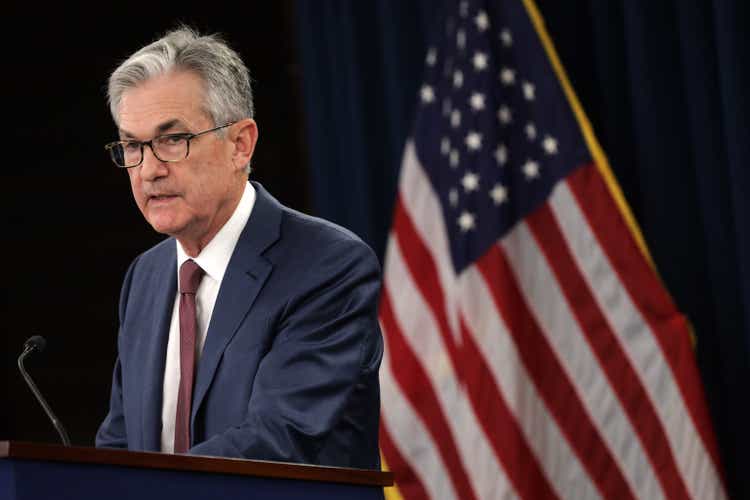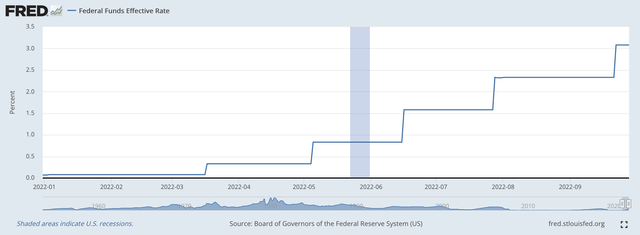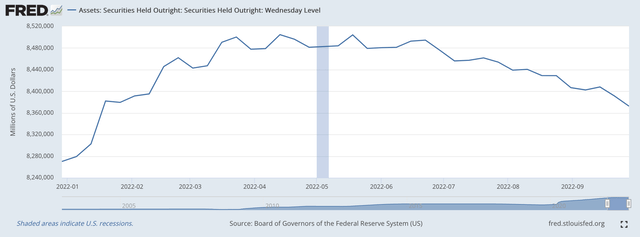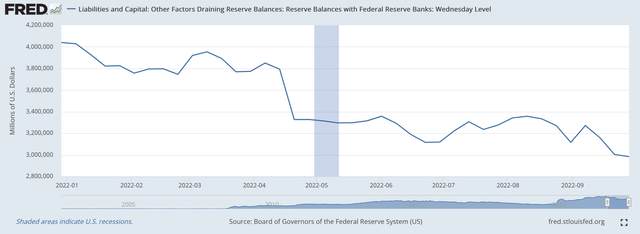Alex Wong/Getty Images News
The effective Federal Funds rate jumped to 3.08 percent this week, 75 basis points higher than it had been resting.
Of course, this is due to the Federal Open Market Committee, the policymaking branch of the Federal Reserve System, moving its target rate up by 75 basis points last week.
So, this is what this year looks like in terms of the Fed’s policy rate of interest.
Effective Federal Funds Rate (Federal Reserve)
So the Federal Reserve is doing exactly what it said it was going to do.
Federal Reserve policymakers also said that they were going to begin to reduce the size of their securities portfolio.
It is doing that as well.
Reduction Of The Securities Portfolio
In the latest banking week, the amount of securities held outright by the Fed closed the week on Wednesday, September 28, 2022, at $8,372.4 billion.
The securities portfolio was reduced by $18.8 billion this past banking week.
Since the end of the March 16 banking week, the portfolio is down by $118.1 billion.
March 16 is the day that the FOMC approved the first rise in the Fed’s policy rate of interest.
This is what the size of the securities portfolio looks like in a chart.
Securities Held Outright (Federal Reserve)
Note that from the end of March through June of this year, the securities portfolio remained relatively constant.
However, once the Fed got into June, the Fed seriously began to reduce the size of its securities portfolio. Since June 22, 2022, the securities portfolio has shrunk by $122.1 billion.
Reduction Of Commercial Bank Excess Reserves
The reduction in the Fed’s portfolio of securities helps to shrink the amount of liquidity that is present in the commercial banking system.
The amount of Reserve Balances with Federal Reserve Banks, a line item on the Fed’s balance sheet (see Fed statistical release H.4.1, Factors Affecting Reserve Balances of Depository Institutions and Condition Statement of Federal Reserve Banks. The specific chart under review is titled Factors Affecting Reserve Balances of Depository institutions.)
The line item titled Reserve Balances with Federal Reserve Banks can be looked at as a proxy for excess reserves in the commercial banking system.
In general, if “reserve balances” go up, the banking system has more excess reserves on its books. This would indicate a looser monetary system, which generally would result in a lower policy rate of interest.
If “reserve balances” go down, the Fed is usually “tightening up” on monetary policy, liquidity is tightening up, and the policy rate of interest would usually go up.
Here are the results for this year.
Reserve balances remained relatively flat through March into April. Then the “excess reserves” in the banking system really began to decline.
Reserve Balances With Federal Reserve Banks (Federal Reserve)
They have continued to decline up to the end of the present banking week.
So, the reduction in the Fed’s security portfolio is helping to reduce the liquidity in the banking system and, consequently, supporting the Fed’s efforts to raise its policy rate of interest.
The Fed is sticking to its promised policy path.
But, it still has a long way to go.
And, there are many uncertainties and many unknowns ahead.
This is why we must keep our eyes on what the Fed is doing and what they say they are doing.
So far, what the Fed is doing is consistent with what they have been saying.
But, keep your eyes open.


Be the first to comment